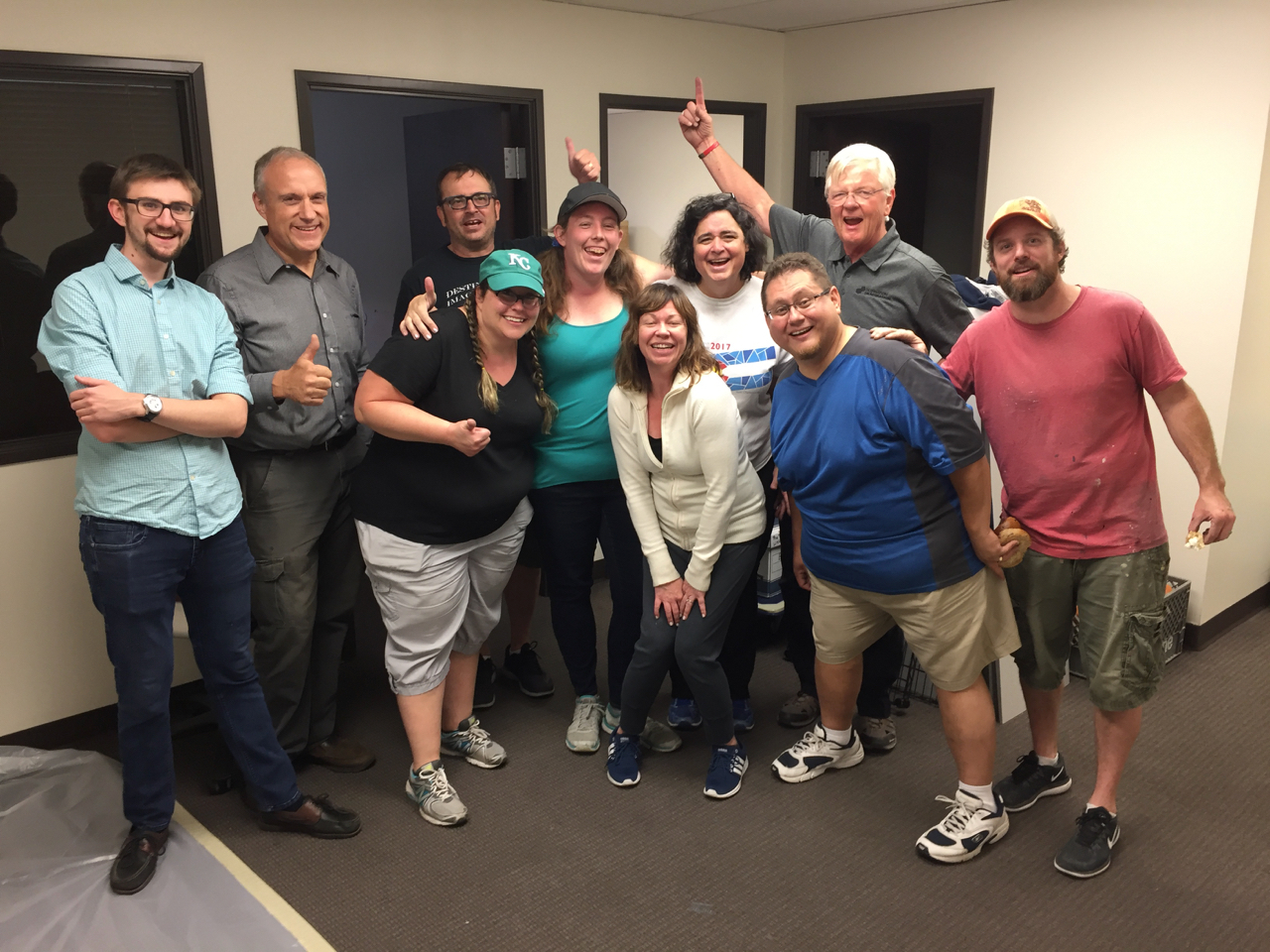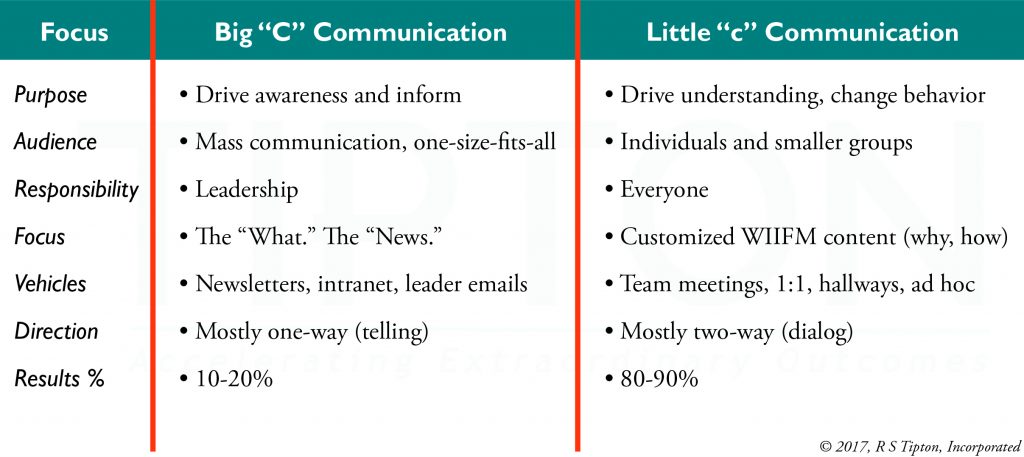
06 Sep To Drive Change, Use the Right Kind of Communication!
Our recent blog posts have helped illustrate the Seven Core Beliefs of a Transformational Change Leader, and as we’ve heard from readers, it’s clear that communication is essential ingredient for change. Note the small “c” there – the communication we are talking about is not the polished market-ready messages of the Communications Department, but rather the transfer of meaning to help explain the change, meaning that appeals to both head and heart, and that elicits curiosity, understanding and engagement.
We thought it would be a great time for you to hear from Team Tipton’s Practice Leader for Enterprise Communications, Dan Clemens. Dan is leading our September 21 webinar Building Highly-Effective Communications Plans. (more on this below). Here’s what he has to share with you about why it’s so vital to “communicate” not “Communicate” if you want to drive change.
Enjoy!
Team Tipton
Consider the following:
“Today we are excited to announce a realignment of our division to better support the organization’s strategy and goals …”
Most of us have read a message like that at some point in our careers. Mergers, acquisitions, reorgs, new leaders, right-sizings, or the formation of a new group have become commonplace, and organizational change is a way of life for many.
The trouble is, much of the Communication we receive rarely helps us understand and embrace the change. Although Corporate Communications departments often burn the midnight oil to craft messages to support the announcement, their materials only tell our heads what is happening – they don’t touch our hearts or change our behavior.
Of course, there is a place for polished, unidirectional Communications that is the expertise of your Communications Department. But organizational change requires a deeper level of support across the entire organization that involves more than telling your staff what’s going on at the upper levels.
The responsibility for the kind of communication that creates personalized meaning, changes behavior and ultimately drives engagement falls to leaders, managers and other champions of change. In other words, you.
You and your management team are the ones who will make sense of the change in a deeper way by customizing the message, explaining the implications for individuals and work teams and answering, “What Does This Mean To Me?”
Communication vs. communication
We are talking about two different kinds and definitions of communication. We must distinguish between Communication (capital C) that refers to big picture, mass media messages using organization-wide vehicles, and communication (little c), which is the day-to-day, small group dialogue between leaders and employees.
For change to be effective, accepted and embraced, the organization needs both Communication and communication. Think of the role of the Corporate Communications department to provide the big picture. If you were preparing a meal, Communication is the menu – it paints the high-level understanding of what and when we’re going to eat. On the other hand, consider your communications efforts as the shopping list and recipe – it’s the fine detail of what you need to come together to make the evening a success.
To be clear, communication is not the sexy side of the equation, but it is the most effective way to create and sustain change … it’s hard work that takes time.

For example, you may be frustrated if you are a leader two months into a new initiative and aren’t enjoying an engaged workforce performing as you’d like. After all, you worked with Corporate Communications on the messaging and approved all the materials. You’ve Communicated.
Step back for a moment … have you Communicated or have you communicated? When change isn’t going as expected or hoped, you need to boost your communication, not your Communication.
Disengaged, confused or underperforming employees have probably already wrapped their heads around the change with the initial Communication. To fully engage and achieve, they need the opportunity for dialogue, to ask questions and hear passion in your voice. They need help translating the Communication into what it means for them. Sustaining dialogue with your team builds strong relationships that will pay dividends long after the change is complete.
Tips to Boost communication in Your Organization
Dialogue. Increase the opportunities for individual, small group and team dialogue. Designate time for Q&A in existing meetings and look for other situations to initiate and encourage dialog.
Be Visible. Walk the floors, drop in on meetings and strike up conversations in cubicles and the break room. The worst thing a leader can do is stay behind closed doors during change – people will automatically think the leader is hiding something
Listen. More than anything, employees want to feel like they are being heard in times of change. They need the opportunity to vent frustrations, express fears and ask questions. Your best move is to ask questions and then listen, listen, listen.
Reward and Recognize. Success breeds success. As you work through the change process highlight victories, no matter how small. This could be someone using the new process, a customer win or some other benefit / efficiency the change has made possible. Recognize those who are onboard and trying.
Collaborate with Corporate Communications. Capture the questions you get and forward them to the Corp Communications team. As you look at a more complete list of questions and concerns you’ll often see common misperceptions and gaps in understanding. This is where the Communications staff can help craft messaging and create additional Communication materials. You can then follow up with additional communication.
Remember change is a process. We all process change at a different pace. Familiarize yourself with the stages in the Transformational Change Curve and plot where your team members are at any given time.
Thank you!
All my best,
Dan Clemens
Want to learn more about how Team Tipton can benefit you and your team?
We’d love to hear from you and set up a short exploratory call.
Schedule yours here.




Victoria Runkle
Posted at 19:24h, 25 November“Small c” communication is so important. Making certain people have the “tools” for this type of communication is important:
* time: for small team meetings; to share learning opportunities;
* attitude: too many managers think when people are talking, they are not working. Make certain there is an attitude in the organization that employees talking = employees developing relationships;
* listen: give people enough time to talk and listen; developing communication is a bit like counseling. People have the answers. It is important just to listen long enough to people;
* be truly interested! make certain people have the right time to be truly interested in co-workers, customers and friends. Ask questions about family or the situation that is being addressed. Certainly there are folks attempting to “squeeze out of responsibility,” but are they really? If you are interested enough, you will discover people have a reason for their needs; and
* create a “no judgement” environment: every employee, beginning with the leaders and managers, must ensure the environment is open enough to listen to all ideas. Nothing will “kill” small communication faster than evaluating everyone’s comments.
“Small c” communication takes time and care. Thanks for the reminders, Dan.
*
teamtiptonadmin
Posted at 14:19h, 26 NovemberThank you, Vik! Love your suggestions — time, attitude, listen, be truly interested, and create a “no judgment” culture — all great things to assist in developing “little c” communications. See you soon!
Dan Clemens
Posted at 14:27h, 26 NovemberGreat insights Vik! Appreciate the comments on listening – in most organizations that might be the weakest communication skill. It takes time, patience, genuine interest and empathy to really listen. But what a tremendous transformation takes place when people feel they are heard!